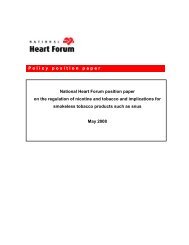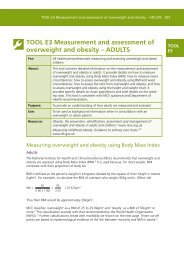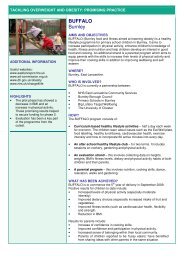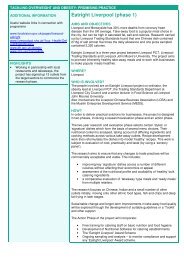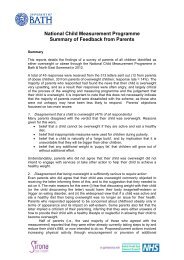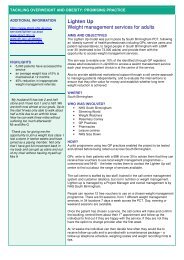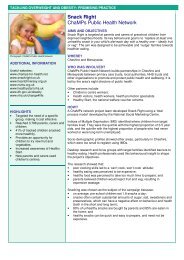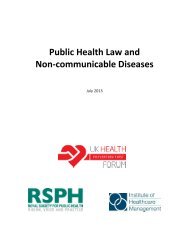The Challenge of Non-Communicable Diseases and Road Traffic ...
The Challenge of Non-Communicable Diseases and Road Traffic ...
The Challenge of Non-Communicable Diseases and Road Traffic ...
Create successful ePaper yourself
Turn your PDF publications into a flip-book with our unique Google optimized e-Paper software.
40 <strong>The</strong> <strong>Challenge</strong> <strong>of</strong> <strong>Non</strong>-communicable <strong>Diseases</strong> <strong>and</strong> <strong>Road</strong> <strong>Traffic</strong> Injuries in Sub-Saharan Africa<br />
Partners such as those in agriculture, trade, finance,<br />
justice, public health, <strong>and</strong> NGOs all have a<br />
role to play, particularly in countries where tobacco<br />
is an important cash crop, <strong>and</strong> the support <strong>of</strong> international<br />
agencies is relevant in developing alternative<br />
livelihoods <strong>and</strong> crop diversification. Regional<br />
cooperation is also important in counteracting illicit<br />
trade <strong>and</strong> in south-south capacity-building: the<br />
Kenyan Revenue Authority, for example, has been<br />
active in sharing its experience <strong>and</strong> supporting other<br />
countries in supply-chain control, tracking <strong>and</strong> tracing<br />
technology, <strong>and</strong> enforcement [94].<br />
Alcohol<br />
A substantive evidence base also shows that making<br />
alcohol more expensive <strong>and</strong> less easily available,<br />
banning alcohol advertising <strong>and</strong> its promotion, <strong>and</strong><br />
enforcing drink-driving legislation or countermeasures<br />
are cost-effective in reducing alcohol-related<br />
harm [244].<br />
Increasing alcohol prices, usually through raising<br />
alcohol taxes, is particularly effective among problem<br />
drinkers <strong>and</strong> youth. Restrictions on availability<br />
include restrictions on sales <strong>and</strong> consumption by<br />
people below a legal drinking age: in some countries<br />
the age for legally buying alcohol is as low as<br />
15 years (Angola). Another means for restriction is<br />
through government control <strong>of</strong> alcohol distribution<br />
<strong>and</strong> sales: in the Gambia, for example, there is a state<br />
monopoly on the production <strong>and</strong> sale <strong>of</strong> beer, <strong>and</strong><br />
alcohol advertising is banned on national television<br />
<strong>and</strong> radio.<br />
Restriction <strong>of</strong> alcohol marketing is one <strong>of</strong> the most<br />
promising strategies for governments in developing<br />
countries [245]. Sophisticated marketing strategies<br />
target African youth, with alcohol portrayed as a<br />
symbol <strong>of</strong> heroism, courage, <strong>and</strong> virility, <strong>and</strong> information<br />
on the risks are missing or on a small scale<br />
[246].<br />
Nevertheless, the infrastructure for enforcement<br />
<strong>and</strong> the monitoring <strong>of</strong> restrictions <strong>and</strong> regulations<br />
may be missing. In the Gambia, the m<strong>and</strong>atory health<br />
warning message on alcohol advertising is rarely enforced<br />
[96]. Violation <strong>of</strong> laws <strong>and</strong> regulations can<br />
extend to the practice <strong>of</strong> ‘shaking h<strong>and</strong>s’ (requesting<br />
<strong>and</strong> providing bribes to the police), an all-too-common<br />
practice for drunk driving <strong>and</strong> car crashes. In a<br />
recent global survey <strong>of</strong> 44 SSA countries, only nine<br />
countries had a national drink-driving law based on<br />
Blood Alcohol Concentration, <strong>and</strong> only one country<br />
(Botswana) rated their enforcement <strong>of</strong> drink-driving<br />
laws as good [59]. Although 25 countries had<br />
targets for reducing alcohol-impaired driving, most<br />
were unable to measure or monitor the prevalence<br />
<strong>of</strong> the problem.<br />
Food<br />
SSA already has a mixed picture <strong>of</strong> malnutrition<br />
<strong>and</strong> overweight/obesity, <strong>and</strong> both can contribute<br />
to NCDs. Efforts to improve food security <strong>and</strong> alleviate<br />
under-nutrition include improvement <strong>of</strong><br />
agricultural productivity, pro-poor primary care,<br />
<strong>and</strong> food programs [247]. <strong>The</strong> time from conception<br />
until two years <strong>of</strong> age is a critical period when<br />
length-for-age can be improved by high-quality<br />
nutrition. Yet, care must be taken, learning from<br />
some programs in Mexico, Chile, <strong>and</strong> Brazil where<br />
under-nutrition was traded for over-nutrition<br />
[248-249] – programs that miss the main opportunity<br />
for height recovery, or that continue to supply<br />
energy-dense foods to children who already meet<br />
weight-for-age criteria, can unintentionally increase<br />
overweight [250].<br />
For NCD prevention, traditional diets, which for<br />
example are high in added salt or sugar or low in<br />
vegetables, could be improved from nutritional <strong>and</strong><br />
public health perspectives. Effective salt-reduction<br />
strategies for a country depend on whether salt consumption<br />
is largely non-discretionary (that is, it is<br />
added during food manufacture) or discretionary<br />
(that is, added during cooking or at the table) [251].<br />
For most countries, it will mean a focus on the food<br />
industry <strong>and</strong> reformulation <strong>of</strong> products [252-253]:<br />
in South Africa, it has been estimated that reducing<br />
the salt content <strong>of</strong> bread, soup mix, seasoning, <strong>and</strong><br />
margarine could achieve 7,400 fewer CVD deaths<br />
<strong>and</strong> 4,300 fewer non-fatal strokes per year [254].<br />
<strong>The</strong> potential for intervening in agricultural policies<br />
to encourage healthy eating appears limited, but<br />
there are important links among agricultural policies,<br />
food industry choices, <strong>and</strong> consumer diets, <strong>and</strong><br />
so the food supply chain as a whole needs to be taken



